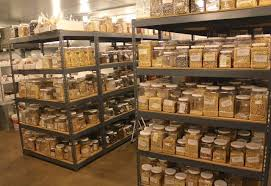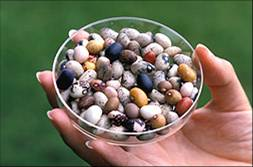Science > Biology > Improvement in Crop variety > Collection and Conservation of Germplasm
From ancient time, humans have collected germplasm from the wild variety and domesticated it.
Domestication:
Domestication is the process of bringing wild species under human management. The domestication of plants is one of the first and most crucial steps in developing a new variety of crop. The present-day cultivated plants have been derived from wild species only. They were domesticated by prehistoric man. The domestication process is a continuous process. For e.g. rice was domesticated in Asia about 8000 years B.C. while maize was domesticated in Central America 7000 years B.C.
Collection of Variability:
Differences or variations in the gene composition of plants or individuals of a group of population or species is called genetic variations. Germplasm is the sum total of all the alleles of the genes present in a crop and its related species. The activity of collection is executed through planning, coordinating and conducting collaborative explorations for collection of germplasm of different agri-horticultural crops and their crop wild relatives from various diversity rich regions.
Characteristics of Germplasm:
- The genetic pool represents the entire genetic variability or diversity available in a crop species.
- Germplasm consists of landraces, modern cultivars, obsolete cultivars, breeding stocks, wild forms and wild species of cultivated crops.
- Germplasm includes both cultivated and wild species and relatives of crop plants.
- Germplasm is collected from centres of diversity, gene banks, gene sanctuaries, farmer’s fields, markers and seed companies.
- Germplasm is the basic material for launching a crop improvement programme.
- Germplasm may be indigenous (collected within the country) or exotic (collected from foreign countries)
Conservation of Germplasm:

There are two important methods of germplasm conservation or preservation. i) In-situ conservation and ex situ conservation. These are described below.
In-situ conservation:
Conservation of germplasm under natural conditions is referred to as in situ conservation. This is achieved by protecting the area from human interference. Such an area is called a natural park, biosphere reserve or gene sanctuary. In this method of conservation, the wild species and compete natural or semi-natural ecosystems are preserved together. Each protected area will cover only a very small portion of the total diversity of a crop species, hence several areas will have to be conserved for a single species. Due to the scattered area, the method is costly.
Ex-situ conservation:
It refers to the preservation of germplasm in gene banks. This is the most practical method of germplasm conservation. By this method, it is possible to preserve the entire genetic diversity of a crop species at one place. As the collection is at one place it is a cheap method of conservation. Handling of germplasm is also easy.
Reasons for Collection of Germplasm:
Rescue Collecting:
If genetic diversity is imminently threatened in an area and in situ conservation methods are not feasible, then germplasm collecting may be required. Such a germplasm collection is known as a recue collection. This collection and conservation are done in the case of a danger of genetic erosion or extinction of target species.
Reasons for Doing Rescue Collection:
- Agricultural change: Traditional major crop may be seriously threatened by the introduction of uniform, modern, or exotic varieties.
- Socioeconomic change: Increase in urbanization, wars or civil unrest may destroy the native variety. Overexploitation: Loss of species caused by overgrazing, uncontrolled harvesting in the wild for medicinal plants, timber species can result in the loss of the species and other species depending upon them.
- Habitat loss: Due to overexploitation of the environment or by uncontrolled urbanization species may lose their habitat.
- Competitors, predators and pests: Introduction of foreign organisms in the ecosystem can destroy species.
- Natural disasters/pollution: Natural disasters like drought, floods, earthquakes, tsunamis and industrial pollution, disease epidemics, can cause danger to some species.
- Construction of a dam: During construction of dam large area gets drown underwater and many species can be lost. Collection of germplasm of species in the affected area where dams are being constructed is required. Such collection was done during the construction of the Sardar Sarovar dam/Tehri dam, etc. It was also done after recent Super Cyclone in Orissa, tsunami-affected areas, etc.
Needed for immediate use:
Sometimes the collection and conservation of germplasm is required for plant breeding, for immediate planting, and land management, etc.
Reasons for the need for immediate use:
- Need by formal sector: There is always a need for new traits and combinations of traits to meet new challenges, and to develop a new variety of the crop with specific traits. New germplasm is acquired through collecting or from other ex-situ collections.
- Need of Local Communities: It is done for immediate planting as per the need of the local community. e.g. plants required for social forestry.
- Non Crop species: The non-crop species which are important for communities and their livestock like forages, multipurpose trees, wild fruits, medicinal species and species important in land management and habitat restoration are targeted.
Gap filling:
This collection is done to fill the gap between the diversity missing from ex-situ collection. e.g. Missing taxa, genotypes and uncollected germplasms from particular areas. Due to change in agronomic pattern, the genetic material not considered useful now may become vitally important in the future. Hence it is important to collect and conserve such germplasm.
Research purpose:
Research is done due to more needs to be known about targeted species. Adequate sampling strategies can be developed if there is sufficient knowledge of the distribution of genetic diversity among and within populations.
Opportunistic reasons:
fortuitous collection: germplasm contains striking features or is found under unusual circumstances.
Methods of Conservation of Germplasm:
Seed banks:
Germplasm is stored as seeds of various genotypes. Seed conservation is quite easy, relatively safe and needs minimum space.

Plant Bank:
It is an orchard or a field in which accessions of fruit trees or vegetatively propagated crops are grown and maintained. They require large areas. They are expensive to establish and maintain, prone to damage from disease, insect attacks, natural disasters, human handling errors.

Shoot tip banks:
Germplasm is conserved as slow growth cultures of shoot-tips and node segments. Conservation of genetic stocks is conserved by meristem cultures. In this method, each genotype can be conserved indefinitely free from virus, other pathogens, natural disasters. It is advantageous for vegetatively propagated crops like potato, sweet potato, cassava etc. because seed production in these crops is poor.
Cell and organ banks:
A germplasm collection based on cryopreserved (at – 196OC in liquid nitrogen) embryogenic cell cultures, somatic/ zygotic embryos is called cell and organ bank.
DNA banks:
In these banks, DNA segments from the genomes of germplasm accessions are maintained and conserved.
Gene banks for various crops in India
|
Institutes |
Crops |
|
Central Institute for Cotton Research, Nagpur |
Cotton |
|
Central Plantation crops Research Institute, Kasargod |
Plantation crop |
|
Central Potato Research Institute, Simla |
Potato |
|
Central tobacco research Institute, Rajahmundry |
Tobacco |
|
Central tuber crops research Institute, Thiruvananthapuram |
Tuber crops other than potato |
|
Central Rice Research Institute, Cuttack |
Rice |
|
Directorate of Oilseeds research, Hyderabad |
Oilseeds |
|
Directorate of Wheat Research, Karnal |
Wheat |
|
Indian Agricultural Research Institute, New Delhi |
Maize |
|
Indian Grassland and Fodder Research Institute, Jhansi |
Forge and fodder crops |
|
National research centre for sorghum, Hyderabad |
Sorghum |
|
International Crops Research Institute for Semi-Arid Tropics |
Groundnut, Pearl millet, Sorghum, Pigeon pea and Bengal gram |
List of important International Institutes conserving germplasm:
|
Name |
Institute |
Activity |
|
IRRI |
International Rice Research Institute, Los Banos, Philippines |
Tropical rice |
|
CIMMYT |
Centre International de-Mejoramients de maize Trigo, El Baton, Mexico |
Maize and wheat (Triticale, barely, sorghum) Maize collection – 8000 |
|
CIAT |
Center International de-agricultural Tropical Palmira, Columbia |
Cassava and beans, (also maize and rice) in collobaration with CIMMYT and IRRI |
|
IITA |
International Institute of Tropical Agriculture, Ibadan, Nigeria. |
Grain legumes, roots, and tubers, farming systems. |
|
CIP |
Centre International de-papa-Lima. Peru |
Potatoes |
|
ICRISAT |
International Crops Research Institute, for Semi-Arid Tropics, Hyderabad, India |
Sorghum, Groundnut, Cumbu, Bengalgram, Redgram. |
|
WARDA |
West African Rice Development Association, Monrovia, Liberia |
Regional Cooperative Rice Research in Collaboration with IITA and IRRI |
|
IPGRI |
International Plant Genetic Research Institute, Rome Italy |
Genetic conservation. |
|
AVRDC |
The Asian Vegetable Research and Development Centre, Taiwan |
Tomato, Onion, Peppers Chinese cabbage. |
Previous Topic: Improvement in Crop Variety
Next Topic: Step – 2: Selection and Testing of Superior Recombinants

One reply on “Step-1: Collection and Conservation of Germplasm”
very good summary